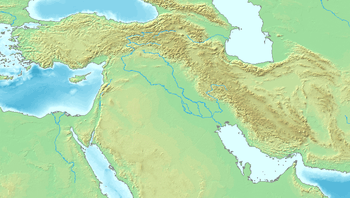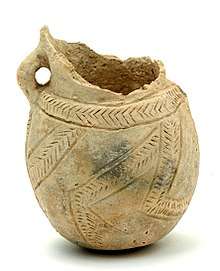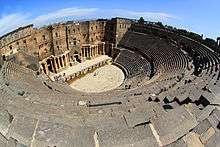Yarmukian culture
The Yarmukian culture (Hebrew: הַתַּרְבּוּת הַיַּרְמוּכִית) was a Pottery Neolithic A (PNA) culture of the ancient Levant. It was the first culture in prehistoric Israel and one of the oldest in the Levant to make use of pottery. The Yarmukian derives its name from the Yarmouk River, which flows near its type site of Sha'ar HaGolan, near Kibbutz Sha'ar HaGolan at the foot of the Golan Heights. This culture existed alongside the Lodian and the Nizzanim cultures to the north.
 Sha'ar HaGolan Map showing the region of Sha'ar HaGolan, type site of the Yarmoukian culture. | |
| Geographical range | Levant |
|---|---|
| Period | Neolithic |
| Dates | 6400–6000 BC |
| Type site | Sha'ar HaGolan, Israel |

Related sites
Besides the site at Sha'ar HaGolan, 20 other Yarmukian sites have been identified in Israel, Jordan and Lebanon.[1] These include:
- Ain Ghazal (Jordan)[2]
- 'Ain Rahub (Jordan)[2]
- Byblos (Lebanon)[3]
- Hazorea (Jezreel Valley, Israel)[2][3]
- HaBashan Street, Tel Aviv, 500 m south of the Yarkon River (Coastal Plain, Israel)[3]
- Hamadiya (central Jordan Valley, Israel)[2][3]
- Jebel Abu Thawwab (Jordan)[2]
- Munhata (central Jordan Valley, Israel)[2][3]
- Nahal Betzet II settlement (Northern Coastal Plain, Israel)[4]
- Nahal Zehora II settlement (southern Jezreel Valley, Menashe Hills, Israel)[4][5]
- Nahal Zippori 3 settlement (Western Galilee, Israel)[4]
- Wadi Qanah Cave (western Samaria Hills, West Bank)[3]
- Tel Far'ah (North) (Samaria Hills, West Bank)[3]
- Tel Kabri (Northern Coastal Plain, Israel)[6]
- Tel Megiddo (Jezreel Valley, Israel) - Yarmukian settlement at the base of the tell[3]
- Tel Qishyon/Qishion/Kishion (wrongly spelled as Tel Kishon by the press) near Mount Tabor (Lower Galilee, Israel)[2][3]
- Wadi Murabba'at Cave (Judaean desert, West Bank)[3]
- Wadi Shueib (Jordan)[2]
Although the Yarmukian culture occupied limited regions of northern Israel and northern Jordan, Yarmukian pottery has been found elsewhere in the region, including the Habashan Street excavations in Tel-Aviv and as far north as Byblos, Lebanon.
Bibliography
Part of a series on the |
|---|
| History of Israel |
 |
| Ancient Israel and Judah |
| Second Temple period (530 BCE–70 CE) |
| Late Classic (70-636) |
| Middle Ages (636–1517) |
| Modern history (1517–1948) |
| State of Israel (1948–present) |
| History of the Land of Israel by topic |
| Related |
|
|
Part of a series on the |
|---|
| History of Syria |
 |
| Prehistory |
| Bronze Age |
| Antiquity |
| Middle Ages |
|
| Early modern |
| Modern |
|
| Timeline |
|
|
- Stekelis M. 1972. The Yarmukian Culture. Jerusalem: Magnes Press.
- Garfinkel Y. 1993. The Yarmukian Culture in Israel. Paleorient, Vol 19, No. 1, pp. 115 – 134.
- Garfinkel Y. 1999. The Yarmukians, Neolithic Art from Sha'ar Hagolan. Jerusalem: Bible Lands Museum (Exhibition Catalogue).
- Garfinkel Y. and Miller M. 2002. Sha'ar Hagolan Vol 1. Neolithic Art in Context. Oxford: Oxbow.
- Garfinkel Y. 2004. The Goddess of Sha'ar Hagolan. Excavations at a Neolithic Site in Israel. Jerusalem: Israel Exploration Society (Hebrew version published in 2002 as: Sha'ar Hagolan. Neolithic Art in the Jordan Valley. Jerusalem: Israel Exploration Society).
- Garfinkel Y. and Ben Shlomo D. In press. Sha'ar Hagolan Vol. 2. Qedem. Jerusalem: Institute of Archaeology, Hebrew University.
- Garfinkel Y., Vered A. and Bar-Yosef O. 2006. The Domestication of Water: The Neolithic Well of Sha'ar Hagolan, Jordan Valley, Israel. Antiquity 80: 686–696.
- Obaidat Daifallah 1995. "Die neolithische Keramik aus Abu Thawwab/Jordanien". Berlin, ex Oriente.
See also
References
| Wikimedia Commons has media related to Yarmukian Culture. |
- Garfinkel, Y. 1999.
- Yorke M. Rowan, Jonathan Golden, The Chalcolithic Period of the Southern Levant: A Synthetic Review, Journal of World Prehistory, April 2009, 22:1–92, DOI 10.1007/s10963-009-9016-4, accessed 27 December 2019
- Garfinkel, Yosef (1993). "The Yarmukian Culture in Israel". Paléorient (19–1): 115–134. Retrieved 27 December 2019.
- Vieugué, Julien; Garfinkel, Yosef; Barzilai, Omry; van den Brink, Edwin C. M. (2016). "Pottery function and culinary practices of Yarmukian societies in the late 7th millennium cal. BC: First results". Paléorient (42–2): 97–115. Retrieved 27 December 2019.
- Avi Gopher and Estelle Orrelle, Preliminary Report on Excavations of Nahal Zehora II — Seasons of 1990 and 1991, Mitekufat Haeven: Journal of the Israel Prehistoric Society, 1991, pp. 169-172, accessed 27 December 2019
- Kempinski, A.; Marder, O.; Prausnitz, M.W.; Khalaily, H.M.; Bankirer, R.Y. (2002). "7". In Scheftelowitz, N.; Oren, R. (eds.). Tel Kabri: The 1986-1993 Excavations Seasons. Tel Aviv: Emery and Claire Yass Publications in Archaeology. p. 305. ISBN 965-266-015-9.